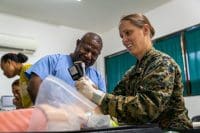Healthcare delivery changes during the pandemic may be permanent.
Telehealth became a primary means of healthcare delivery during the COVID-19 pandemic, and, as Joelle Fathi, DNP, RN, ARNP, ANP-BC, sees it, “We’re a changed world as a result.”
“There’s almost no one who hasn’t been touched by the need to seek healthcare services at a time when it wasn’t easy, convenient, or safe to go to hospitals or clinics,” adds Fathi, the former clinical program director for telehealth clinics at Swedish Health Services in Seattle. “I truly hope it’s a point of no return in terms of our forward motion in advancing telehealth.”
Forward motion requires making changes in care delivery models for health services, development of telehealth policies that support telehealth, including providing coverage for such services, and securing appropriate equipment for use in telehealth. It also requires integrating telehealth content into nursing school curricula and developing telehealth competencies and education for practicing nurses, many of whom have learned on the job. “Nursing fills an incredible role in the telehealth space currently,” Fathi says, and it’s bound to continue expanding, especially if nurses help shape the space and their roles in it.
Fathi currently practices as a primary care nurse practitioner at Seattle’s Virginia Mason Medical Center. Through her participation in the Washington State Telehealth Collaborative, she supported development of a state bill that would mandate coverage of audio-only telehealth beyond the pandemic, as long as the services meet certain conditions. She also had a hand in a new state law that requires telehealth training for nurse practitioners, nurses, and other licensed healthcare professionals who deliver telehealth services.
A burgeoning landscape
The landscape Fathi sees for nurses and advanced practice nurses in telehealth is vast, spanning a variety of settings from hospitals and clinics to homes and long-term care facilities, and covering not only triage and acute care but chronic disease management and support for self-care, remote diagnosis, continuous monitoring and treatment planning, and, increasingly, mental health and behavioral health services. “I can’t emphasize enough how important telehealth is in the mental health, substance [use disorder], and behavioral health realm,” she says, adding that nurses also have opportunities to serve as telepresenters who facilitate patient telehealth visits—especially for those living in rural and remote areas—with other healthcare providers. (See Telepresenter in action.)
Ninette D. Swanson, BSN, RN, who lives on the North Olympic Peninsula, several hours from Seattle, spends part of her nursing life as a telepresenter for several Swedish Health Services clinics. A telepresenter facilitates the interaction between the patient and the remote provider by providing information. For example, for patients with Parkinson’s disease and other movement disorders, Swanson uses a web camera to allow the remote provider to assess the patient’s gait and balance, and she examines the patient’s muscle tone and fine and gross motor skills. For patients with pulmonary disorders, she uses a Bluetooth-enabled stethoscope for pulmonary and cardiac assessment. In addition to using advanced skills assessment, “I’m also advocating for the patient, helping to explain difficulties and frustrations that they may not have remembered or had difficulty explaining,” Swanson says. She spent a day shadowing Swedish Health providers before beginning her work as a telepresenter. Fathi sees telehealth as an opportunity to deliver timely and efficient care to an array of underserved populations who need realistic access to healthcare services. Not all patients and clinical scenarios are appropriate for telephone connections or audio-video visits, but in many cases telehealth is “the humane thing to do,” Fathi says. “It’s how we can accommodate our patients and do right by them,” some of whom have difficulty taking time away from work, are busy taking care of their children or elderly parents, or have little money for gas or bus fare. States historically have defined telehealth practice, making it essential that nurses engaging in telehealth are licensed and understand the laws of the state in which their patient is located. As states consider expanding telehealth, Fathi says, “We [nurses] need to come forward with our expert voices to support bills that will facilitate the critical work we’re doing on the frontlines.” Outcomes data comparing telehealth care to in-person visits will increasingly be available as researchers analyze a plethora of data stemming from care delivery during the pandemic. Over the years, some have voiced concerns that telehealth would be inappropriately used and incongruent with in-person care, Fathi says, and “we didn’t have any data to demonstrate to the contrary because we hadn’t been consistently seeing patients by telehealth and studying it.” Professional nursing organizations are contributing to this important work with more comprehensive telehealth practice guidelines. For example, the American Association of Critical Care Nurses recently updated its 2013 teleICU guidance with a new expert consensus statement on the implementation and improvement of teleICU nursing practice (tinyurl.com/dtyeh3m9). In 2019, the American Nurses Association issued Core Principles on Connected Health (tinyurl.com/3euabwa2). One of these principles is that nursing is responsible for developing competencies to ensure safe and effective telehealth delivery. Nursing education programs are now integrating telehealth content within undergraduate and graduate curriculum. Fathi believes this is bound to flourish. An 8-hour telehealth curriculum for nurse practitioner training in many tracks at the University of Washington School of Nursing, where she’s an associate teaching professor, is in its second year. The curriculum, developed in large part with funding from the U.S. Department of Health and Human Services, incorporates the educational components now mandated by the state, including legal and regulatory matters, patient consent, and health information privacy. It also emphasizes the importance of determining when telehealth care is appropriate and when to redirect patients to in-person care. The training concludes with a simulated telehealth visit with a standardized patient. The past year has forced a change in how we deliver healthcare. Telehealth has made it possible for patients to continue to receive care safely and has opened our eyes to how we can continue to use it to benefit patients who otherwise might not see a provider. States, nursing education programs, healthcare organizations, and individual nurses must work together to develop policies and guidelines that ensure ongoing safe telehealth care that meets patients’ needs. Christine Kilgore is a medical writer in Falls Church, Virginia. Telepresenter in action
Reaching more patients
Education and regulation
Expanding care and opportunities


















